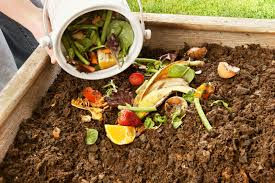Preparing Your Compost For Winter: A Gardner's Guide
- Michelle Nieuwenhuis
- Sep 24
- 3 min read
Updated: Oct 6
The cool fall air begins to seep through our open windows as we sleep; the temperature drops at night and the days grow shorter. Summer is ending and fall is in full swing with winter not too far on its tail. Many gardeners have already begun winding down their outdoor projects for the year, but one essential task can often be overlooked during fall cleanup: preparing your compost bin for winter.
Composting in the winter is similar to composting in the summer but in slow motion. The colder months will cause your food scraps to freeze, but with the right approach, your compost pile can continue to break down even in the cold. Set yourself up for rich, nutritious soil in the spring by preparing your compost for winter with this step by step guide.
Dissemble Your Bin

We want to ensure that our compost bin will have adequate space to continue to hold food scraps while decomposition has slowed during the colder months. First, we will want to dissemble and empty your bin.

Assess Your Current Pile
Check the state of your compost. Does your compost have a good balance of green (nitrogen-rich) and brown (carbon-rich) materials? The golden ratio for green to brown material is equal parts green and brown materials by weight. Add the appropriate material to your bin before turning it.
How is the moisture level? Try a squeeze test: grab a handful of compost and give it a squeeze. An ideal moisture level for compost is about as damp as a wrung-out sponge; only a few drops of water should be released and the material should stay in a clump for a few seconds after opening your hand. Compost that crumbles to pieces in your hand is too dry, while compost that drips down your hand is too wet. If it's overly wet, turn it and add more dry browns like shredded leaves or cardboard. If it's too dry, water it slightly as you mix.
Are there any recognizable pieces of material that haven’t fully decomposed? Incorporate those materials while you turn your pile.
A well-balanced pile will generate internal heat extending some decomposition activity as winter approaches.
Reconstruct Your Bin

Reconstruct your bin next to your pile or select a new location. Ensure your bin is accessible. In Wisconsin, we’re expected to have large amounts of snow accumulation, keep that in mind as you reconstruct your bin. Consider placing your bin in a sunnier location to extend the decomposition process as we approach the colder months.

Stockpile Browns
In fall, brown material is everywhere: leaves, dried garden plants, dead grass, and even newspaper. Collect and store these in bags or bins nearby. You’ll need them throughout winter to balance out green additions like kitchen scraps. Since browns are hard to come by in mid-winter, stockpiling now keeps your compost going year-round. You could also purchase woodchips or straw from a store or local farmer.
Keep Feeding It
Once your bin is reassembled (and emptied), you’re ready to begin the process all over again! Keep adding your food scraps — veggie peels, coffee grounds, eggshells — and layer them with your stockpiled browns. Avoid large chunks or whole fruits, which break down slowly. Chop or shred materials for faster decomposition. If you get snow, simply lift the tarp or lid and toss in your scraps. Just because its winter doesn’t mean you need to stop composting. Your pile will likely freeze and become dormant, but keep layering every time you add food scraps. This will set it up nicely for when the first thaw happens in spring giving it a jump start in March/April.

One More Good Turn
Your compost will freeze during the colder months and you won’t be able to turn it. Give it one more good turn before the ground freezes. This will help aerate, distribute moisture, and activate decomposition. After the ground freezes, let your compost bin sit, adding materials in layers throughout winter.
Backup Plan or Indoor Option

Maybe managing a pile in the snow isn’t appealing to you – that’s okay! Consider starting an indoor system like vermicomposting or another indoor method. Composting indoors can keep things convenient and productive even when it’s cold outside. A couple years ago, Recycling Connections started a vermicomposting system, read about our experience here.
Final Thought: Compost Never Sleeps
Even in winter, nature keeps working. With a little preparation, you can continue to compost as the snow piles. This will have your pile ready to transform waste into garden gold come the first thaw. Take the time this fall to build it up, balance it out, and cover it well — your spring soil will thank you.
Additional Resources:
Quick video clip documenting this process: https://www.recyclingconnections.org/composting
A more in depth look at this process










Comments